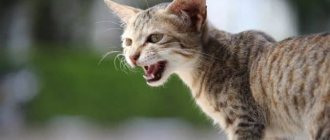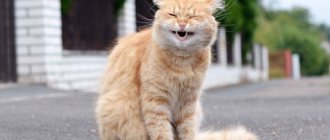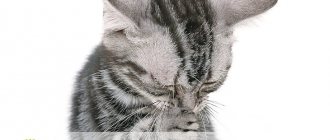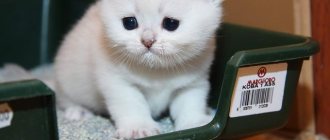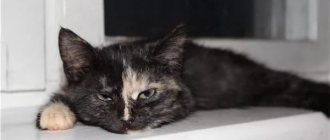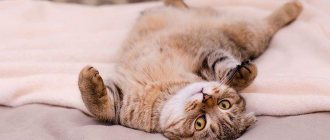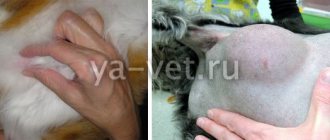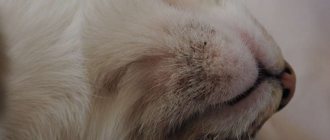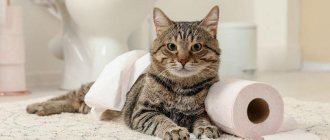It’s nice to communicate and play with cats: they are affectionate, fluffy, they like to bask in a person’s arms, purring... But sometimes our pets disturb us by making sounds that are not entirely “understandable”. Sometimes animals cough, sneeze, and sniffle. But all this is understandable. The cat could have caught a cold, or there might have been debris in his nose. But what if the cat grunts when breathing? Agree, it’s much more common to hear such sounds from a piglet, but not at all from your favorite furry “beast.”
Natural predisposition
Among the many cat breeds, there are brachycephalic varieties, which have a skull structure that is atypical for other species. These are the well-known Persian and British cats, as well as their mestizos, which are characterized by a “flat” muzzle and a shortened head shape. Due to abnormal physiology, such animals have :
- frequent colds during the cold season;
- difficulty breathing in hot weather;
- low filtration ability, so dust and other small particles have a sharp irritating effect;
- violations of the structure of the soft palate, which interfere with normal air flow.
A cat's characteristic grunt accompanies each of the described situations. In everyday life they snore and wheeze. A cat may sneeze when it has a cold or in dusty rooms. The abnormal shape of the palate not only makes breathing difficult, but also provokes vomiting. The only solution to the problem can be surgery.
Video
It’s nice to communicate and play with cats: they are affectionate, fluffy, they like to bask in a person’s arms, purring... But sometimes our pets disturb us by making sounds that are not entirely “understandable”. Sometimes animals cough, sneeze, and sniffle. But all this is understandable. The cat could have caught a cold, or there might have been debris in his nose. But what if the cat grunts when breathing? Agree, it’s much more common to hear such sounds from a piglet, but not at all from your favorite furry “beast.”
If you are the owner of an “Englishman” or a cat of nature, then you will most likely have to come to terms with his “oddities”. The fact is that animals of these breeds belong to the so-called brachycephalic varieties. This is the “scientific” name for mammals that have a shortened head with a characteristic “flat” muzzle.
In the process of breeding such animals, breeders encountered a lot of difficulties. So, the same Persians have a lot of genetic anomalies, many of which are tied to the genome, which provides these animals with a shortened full face of the skull. Whatever one may say, from a natural point of view such a structure is nonsense. In particular, all cats of these varieties are extremely unstable to the effects of very high and low temperatures:
the air simply does not have time to warm up or, on the contrary, cool down in their nasal cavity.
In winter, Persians and cats similar to them constantly catch colds (they should not be allowed outside at all when the ambient temperature drops below 10° Celsius). In the summer, it’s hard and difficult for them to breathe in the heat - hence the “grunting”. Because of this, your pet regularly sneezes when he gets into a dusty room: his respiratory organs simply do not have time to filter everything. But there may be more to it than that.
The problem also lies in the structure of the soft tissues of their palate. Over time, especially in old pets, it can simply “sag,” thereby blocking the normal flow of air. Because of this, the animal becomes even more like a pig. In principle, there is no particular problem here, but... if the grunting becomes incessant, and your cat cannot sleep normally due to “heroic” snoring, we strongly advise you to take him to the veterinarian. It is quite possible that he will need surgery to correct the structure of the soft palate. During the intervention, the surgeon will cut off the “extra” parts that interfere with the normal passage of air. Another sign that “transparently hints” at the need for such a procedure is that which occurs with particularly strong “grunting.” But there are other causes of grunting breathing, many of which are not so “harmless”.
Paroxysmal breathing
Every owner has at least once witnessed a situation where a cat grunts, sneezes and tries to breathe in air at the same time. At the same time, her eyes are wide open, she arches her back and presses her front paws to her chest. Veterinarians describe this condition as paroxysmal breathing. For the most part, it does not pose any threat, but you should be wary if :
- the frequency of attacks increases over a short period of time;
- a secondary symptom is vomiting, especially with blood;
- The cat began to sleep restlessly and seemed to be suffocating in his sleep.
Not only cats, but also dogs suffer from this. Attacks can be considered rare if they occur no more than 1-2 times a month. If the problem begins to bother you every day, you need to consult a doctor as soon as possible.
How to use Nazivin spray
The Nazivin form is indicated for the treatment of runny nose in children 1–6 years old. The bottle with the drug must first be shaken and a test spray into the air.
- Before use, the nasal passages are cleared of mucus clots with a cotton swab, the child is allowed to blow his nose, and if possible, the sinuses are washed with a special saline solution or water.
- Throwing your head up, carefully bring the dispenser to your nostrils and inject the drug once.
- The procedure is repeated up to three times a day.
The general course of treatment is up to 7 days.
Helminthiasis
Extensive parasite infestation may explain why the cat grunts. Some types of worms develop in the lungs. By feeding on blood, tissues and multiplying in the respiratory tract, helminths provoke the occurrence of an inflammatory process and the formation of pathogenic microflora. As a result, the cat develops breathing problems accompanied by grunting.
In advanced stages, grunting and coughing result in vomiting, in which live parasites can be found. Treatment of pets with anthelmintic drugs should be carried out not only for therapeutic, but also for preventive purposes.
Helminthiasis
An animal carrying parasitic worms can make unusual grunting sounds.
Toxocara. The development cycle of the Toxocara nematode begins with the cat swallowing food infested with larvae or eating the intermediate host of the parasite, which is:
- mouse;
- rat;
- bird;
- insect.
Development in the body. In the intestine, the larva actively invades the blood vessel through the epithelial wall in order to enter the lungs with the bloodstream. Young parasites feed on the blood and tissues of the airways, causing severe irritation, difficult wheezing breathing and a reflex cough.
The damaging effect leads to the attachment of pathogenic bacteria that increase inflammation. With a cough, some of the larvae enter the oral cavity and are swallowed again, growing in the intestines into a mature worm. During the period of migration of larvae into the digestive tract, the cat may experience the urge to vomit.
Hookworm. Hookworm larvae cause hookworm disease by entering the cat’s body in several ways:
- simultaneously with food and water;
- when self-licking;
- through the skin with subsequent penetration into the bloodstream;
- when eating infected rodents.
Development. The path of larvae that have penetrated through the skin into the blood lies in the respiratory tract, and then, when coughing, into the oral cavity.
Clinical picture of helminthic infestation. Infection with helminths in a cat is indicated by:
- poor appetite and weight loss;
- apathetic behavior;
- disruptions in the gastrointestinal tract;
- increase in abdominal volume;
- the appearance of mucus and blood in feces;
- unkempt appearance, poor coat;
- constant discharge from the eyes;
- pallor of the mucous membranes in the mouth.
Diagnosis and treatment. The diagnosis is based on laboratory tests of blood and feces. Having determined the type of helminth, anthelmintic drugs are prescribed in the required dose and, possibly, with repeated use.
Also watch the video of a cat breathing with wheezing:
Tracheitis
If a cat grunts loudly, often rubs his nose, coughs, refuses to eat and vomits, it is quite possible that his trachea is inflamed. Hypothermia is a common precursor to tracheitis. If treatment measures are not taken in a timely manner, they lead to aggravation of the disease and the development of bronchitis and pneumonia, in which the use of antibiotics is inevitable. Light grunting and periodic coughing may persist even after recovery, which is due to the specific restoration of damaged tissue.
A cat is like a newborn baby who cannot say what is bothering him and requires emergency help when alarming symptoms appear . In addition to the described reasons that can explain why the kitten grunted, the presence of a foreign body in the respiratory tract, the development of a neoplasm and all kinds of infectious processes cannot be ruled out. Grunting in a cat can be a sign of a dangerous disease, so it is better to consult a veterinarian and conduct a thorough examination.
Description of possible causes
If the cat grunts through its nose when breathing, but there is no snot or discharge from the eyes, then it is worth eliminating the option of a foreign body getting into the throat or nostrils, which brings discomfort to the pet.
If there is discharge from the nose, eyes, sneezing and coughing, then it is best not to hesitate to contact a veterinarian, especially in the case of kittens for whom viral diseases are life-threatening.
In adults and individuals and kittens, grunting can be caused by the following reasons.
Foreign body
If an animal gets something into its nasopharynx, it begins to behave restlessly, as it feels discomfort. This often manifests itself as head shaking, coughing, grunting, and rapid breathing.
In most cases, the foreign body is food debris (bones from fish or meat), which irritate the pet’s mucous membrane. Because of this, the cat may take breaths that sound a lot like grunting. Pieces of toys, broken twigs, plant seeds, or weed needles can also get stuck.
It is recommended to independently examine the nasopharynx (if possible) and remove the foreign body using tweezers. If nothing is visible or the splinter is in an inaccessible place, do not hesitate to visit the veterinarian.
Even after removing the irritant, the pet will sniffle and even grunt for some time. This is considered normal, since the mucous membrane is irritated and has not yet healed.
Calicivirus
A common respiratory viral infection that occurs in cats of all ages. At the initial stage it manifests itself in the form of fever, nasal discharge, cough.
As the process progresses, grunting through the nose and purulent discharge from the eyes are added. Also characteristic symptoms of calcivirosis are ulcers that affect the upper palate, tongue, gums, and the inside of the lips and cheeks. You can become infected through close contact with a sick animal (by licking or sniffing each other, scratching or biting).
Calicivirus very often “rages” in nurseries , so it is recommended to be very careful when choosing a kitten. There are many cases where unscrupulous breeders explained the symptoms of a viral infection with the usual characteristics of the breed (sour eyes, grunting nose).
Treatment in each case is individual, since antiviral drugs are prescribed based on the severity of the clinical picture. This could be Amoxicillin and Immunofan.
PCR diagnostics and its correlation with symptoms are of great importance, since it must be remembered that the animal can excrete the virus for up to 2 months after complete recovery. Some individuals remain virus carriers until the end of their lives.
Infectious rhinotracheitis
And although the mortality rate for this disease is small (no more than 8-10%), in kittens it is very painful. Adults are also susceptible to the virus, but their clinical picture is usually not aggravated by weakness, lethargy and impotence.
In general, rhinotracheitis occurs in a standard manner for viral infections – fever, sneezing, sour eyes. Subsequently, grunting through the nose is added due to the abundance of purulent discharge and a wet cough.
It should be remembered that rhinotracheitis is seasonal. For example, most cases are recorded in the spring and autumn. Treatment is strictly symptomatic - mucolytics and expectorants for severe coughs, rinsing the nose if there is snot, treating the eyes for conjunctivitis.
Neoplasms
They can also cause your cat to grunt when breathing. In young individuals, polyps most often occur that grow in the nasal passages. In pets over the age of 10 years, it is necessary to exclude the possibility of an oncological process.
This will require rhinoscopy, radiography, biopsy, histology and cytology. After determining the type of formation, effective treatment is selected (surgical removal, chemotherapy, radiation).
Breed Features
Owners of brachycephalic breeds should remember that in British, Scottish, Persian and exotic breeds, nose grunting can be caused by the anatomical structure of the muzzle. The narrowing of the nasal passages leads to the appearance of whistling, hissing and grunting sounds during breathing. Brachycephalics can also snore heavily, which may come as a surprise to owners who have never dealt with this breed before. Nothing can be done about this (except for surgery, of course).
This is interesting: Do cats swim?
Why is the cat snoring?
The respiratory system of cats is similar to humans. Our pets can sigh, sniffle and even snore in the same way. Most often this happens in a dream. Dreams of cats can consist of various events that cause an external reaction not only in the form of twitching their paws, as if the animal is running, shuddering, but also reactions of the respiratory system.
But if a cat or kitten sniffles not only during sleep, but also when awake, this may indicate the appearance of health problems. In this case, the owners need to more carefully observe the pet, which sniffles when it breathes, and track the duration and frequency of the snoring. This can help in determining the cause of the condition, and in deciding what to do and how to treat the animal.
The most common causes of cat snoring:
- Swelling of the larynx. Most often it occurs due to allergies or foreign objects in the respiratory system. It can be detected during a medical examination and during x-rays.
- Asthma.
- Urolithiasis disease. Snorting may be accompanied by wheezing.
- Parasites. Worms can be found in any organ, including the respiratory system.
- Pneumonia and bronchitis.
- Rhinitis.
- Respiratory infections.
- Heart failure. In addition to snoring, coughing and blue discoloration of mucous membranes are observed.
- Obesity.
Allergic manifestations
Allergies are common among tailed pets. An allergen entering the body during breathing provokes an immune system reaction characterized by irritation and inflammation of epithelial cells, swelling of the mucous membrane of the respiratory tract and accumulation of exudate in the bronchi. As a result, the cat:
- has difficulty breathing through the nose;
- breathes through an open mouth;
- makes wheezing, grunting and coughing sounds.
- dust;
- household chemicals;
- chemical preparations for ectoparasites;
- tobacco smoke;
- aerosols and any flavored perfumes;
- cat litter;
- paint and varnish products;
- flower pollen.
Associated symptoms. Difficulty breathing due to allergies is accompanied by:
- sneezing and watery discharge from the nasal passages;
- redness of the eyes and watery eyes;
- itching and the need to constantly rub the face with your paws;
- redness in the throat, dry cough and difficulty swallowing;
- skin and coat problems.
Diagnosis and treatment
Periodic snoring is normal for humans and animals. If this happens rarely, it should not be a cause for concern. But if it's a cat sniffling while breathing all the time, or even breathing with its mouth open, it should be a cause for concern. Persistent breathing problems can lead to more serious health problems. Most likely, you will need a veterinarian's consultation and treatment, because... It is difficult or even impossible to independently determine the disease. But before contacting a doctor, it is necessary to observe an animal that is sniffling and breathing heavily. To make a diagnosis, exclude various diseases and prescribe the correct treatment, the doctor will need detailed information.
The veterinarian may ask for the following information about a cat who wheezes when he breathes::
- the age of the animal and its lifestyle;
- weight and its relationship with the norm for a given breed;
- how long ago did the wheezing occur?
- Are there other sounds heard when the cat breathes?
- changes in the color of mucous membranes;
- the presence of various injuries (torso, nose, mouth, larynx);
- changes in behavior (low activity, weakness, excitability);
- other symptoms (digestive problems, vomiting, other breathing problems, cough, runny nose, sneezing).
If your cat is breathing poorly through his nose and sniffling, you should not wait for this to go away on its own. Such signs may indicate a serious illness in a cat or kitten that requires immediate treatment.
The nature of the snoring and sounds can often roughly determine the source of the disease.:
- wet rales indicate the presence of phlegm in the respiratory organs;
- dry wheezing indicates the presence of swelling in the bronchi or throat;
- crackling – there may be problems in the alveoli;
- A whistling sound may indicate swelling in the respiratory tract.
Only a qualified specialist should diagnose and prescribe treatment for a cat that wheezes when it breathes. Independent choice of treatment method and incorrect diagnosis of the disease can lead to a significant deterioration in the animal’s condition.
Only timely initiation of treatment and the correct choice of medications can ensure a quick and complete recovery of the pet. You should not rely on the recommendations of other cat owners from forums - each case is individual, even with similar symptoms.
What causes a stuffy nose?
Pets are prone to infectious diseases, since they can often catch a cold while sitting on the floor or in a draft. If a cat has a stuffy nose, the reason may lie at the beginning of the inflammatory process. Only an experienced specialist can make a diagnosis. There you can also get recommendations on treating your pet.
Attention! If there is nasal congestion, it becomes difficult for the animal to assess the surrounding environment, since this organ helps the pet navigate in space and recognize danger. If a cat has a stuffy nose, he experiences a feeling of discomfort
Every owner is obliged to help the animal
Before starting treatment, it is important to determine the cause of this ailment, which may include the following:. If a cat has a stuffy nose, he experiences a feeling of discomfort
Every owner is obliged to help the animal. Before starting treatment, it is important to determine the cause of this ailment, which may include the following:
If a cat has a stuffy nose, he experiences a feeling of discomfort. Every owner is obliged to help the animal
Before starting treatment, it is important to determine the cause of this ailment, which may include the following:
- viral disease;
- the presence of parasites in the body;
- rhinitis, rhinotracheitis or sinusitis;
- hypothermia;
- rotting of the mucous membrane.
Some diseases can be cured on your own, but you need to focus on a well-made diagnosis. In order to cope with severe forms of disease, it is better to consult a veterinarian.
Why can a cat sniff and grunt when breathing?
Quite often, a cat's breathing is accompanied by wheezing. As a rule, physiological factors act as the causes of this phenomenon. Such snoring should not cause concern to the pet owner.
Natural causes
The respiratory system of these animals is similar in structure to humans. They, just like people, can sigh, sniffle, grunt, and snore. In most cases, this occurs due to natural causes and should not be a cause for concern. Your pet's wheezing may appear against the background of:
- Excessive physical activity. In healthy individuals, the respiratory rate depends on the degree of load. A cat breathes most calmly during sleep.
- Nervous shock. Experiencing excitement, fear, rage and excitement, the cat begins to breathe noisily. Breathing may be accompanied by wheezing. This is a short-term condition. It goes away after the source of stress disappears.
- Bearing offspring, feeding young and sexual desire. In all these situations, the cat's breathing quickens.
- Overheating. An overheated pet inhales air not through its nose, but through its mouth. He does it hard, with a whistle. The cat instinctively tries to spread out his whole body on the floor in the coolest room, usually on the tiles in the bathroom.
Pathological factors
Among the pathological reasons that a pet is breathing loudly are:
- Swelling of the larynx. This pathological phenomenon most often occurs against the background of an allergic reaction or foreign objects entering the respiratory system.
- Asthma. The symptoms of this disease are difficult to ignore. It is characterized by attacks of suffocation not only at night, but also during the daytime.
- Formation of stones in the organs of the urinary system. In the presence of stones, breathing is often accompanied by wheezing.
- Helminthic infestations. Worms can affect any organs, including the respiratory organs, leading to disruption of their functioning as a result of blockage.
- Inflammation of the lungs and bronchi.
- Inflammatory process in the mucous membranes of the nose.
- Respiratory diseases.
- Heart failure. In this state, the animal not only breathes poorly, but also coughs. Blueness of the mucous membranes is also noted.
- Obesity. Excess body weight leads to increased stress on all organs, including the heart muscle. The chain of pathological reactions gradually results in such phenomena as heavy breathing and snoring.
- Injuries to the chest, spine, ribs. If the animal sticks out its tongue, it is breathing shallowly, it is trying to inhale more air, as if it is suffocating, most likely, breathing is causing it pain.
Diagnostic methods
To make a preliminary diagnosis and select diagnostic methods, the doctor resorts to the following methods:
- examination of the animal’s upper respiratory tract, mucous membranes, eyes;
- auscultation (listening) of the trachea, bronchi and lungs;
- analysis of data on the conditions of keeping and nutrition of a four-legged patient, information about previous diseases suffered by him, features of the onset of the present pathological process;
- comparison of the animal’s weight with the norm for a given breed and age.
After carrying out the initial diagnostic procedures, the veterinarian prescribes the following types of laboratory and instrumental studies to the four-legged patient:
- clinical, biochemical, virological and bacteriological blood analysis;
- stool examination;
- Ultrasound and electrocardiogram of the heart;
- rhinoscopy;
- bronchoscopy;
- X-ray of the chest organs.
You may also need to consult with specialists. If necessary, the animal is prescribed a dental, oncological and surgical examination. The listed diagnostic procedures are standard. Such procedures are prescribed depending on the clinical picture.
How to help your pet depending on the cause of sniffling and grunting?
After identifying the cause of these symptoms and making an accurate diagnosis, the veterinarian will develop a treatment plan. It requires an integrated approach. Therapy is aimed at improving the animal’s condition and relieving signs of the underlying disease. If a four-legged patient has a cough, antitussive drugs (Sinekod, Bronholitin) are used to eliminate it.
For dry cough, expectorant medications (ammonium chloride, Salbutamol) are indicated. When nasal congestion occurs, the nasal passages are washed with saline solution. To relieve inflammation, they resort to rinsing with chamomile decoction. When the listed remedies are powerless, it is recommended to instill any children's drops (Nazivin, Otrivin, Vibrocil).
The main treatment depends on the diagnosis:
- For helminthic infestations, a course of antihelminthic drugs (Milbemax, Stronghold) is indicated.
- When an allergy is diagnosed, its symptoms are relieved with antiallergic drugs (Suprastin, Tavegil). It is important to identify and eliminate the source of the allergic reaction, otherwise treatment will be useless, and attacks of this disease will appear again and again.
- For infectious diseases, antibiotics or antiviral agents are prescribed.
- Symptoms of heart failure are eliminated with the help of glycosides and potassium-containing medications.
- For injuries of the chest, spine, and ribs, immobilization, antibiotic therapy, and painkillers are indicated.
- For obesity, a diet is prescribed.
- Inflammatory diseases are treated with anti-inflammatory drugs and broad-spectrum antibiotics (Streptomycin, Erythromycin).
- When diagnosing asthma, glucocorticosteroids and bronchodilators are indicated.
Preventive actions
To prevent the listed diseases, one of the symptoms of which is sniffling and grunting in a pet, the following safety measures must be observed:
- Carry out vaccinations and deworming in a timely manner. Such measures will help avoid the development of infectious diseases and the appearance of parasites.
- If your pet has an allergy, eliminate its sources in the apartment and avoid the cat’s contact with allergens outside the home.
- Avoid overeating. Do not leave uneaten food in the bowl. If you gain excess weight, it is recommended to switch your pet to a low-calorie diet. Sterilized cats and neutered cats must be fed special food.
- Avoid hypothermia and overheating of the pet and drafts.
- Increase the animal’s immunity through the regular use of vitamin and mineral complexes, agreed with the veterinarian.
- Conduct regular preventive veterinary examinations to promptly identify existing diseases.
- Start eliminating signs of pathologies immediately after they are identified.
Source
